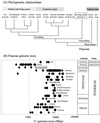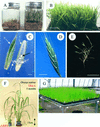Brachypodium distachyon. A new model system for functional genomics in grasses
- PMID: 11743099
- PMCID: PMC133562
Brachypodium distachyon. A new model system for functional genomics in grasses
Abstract
A new model for grass functional genomics is described based on Brachypodium distachyon, which in the evolution of the Pooideae diverged just prior to the clade of "core pooid" genera that contain the majority of important temperate cereals and forage grasses. Diploid ecotypes of B. distachyon (2n = 10) have five easily distinguishable chromosomes that display high levels of chiasma formation at meiosis. The B. distachyon nuclear genome was indistinguishable in size from that of Arabidopsis, making it the simplest genome described in grasses to date. B. distachyon is a self-fertile, inbreeding annual with a life cycle of less than 4 months. These features, coupled with its small size (approximately 20 cm at maturity), lack of seed-head shatter, and undemanding growth requirements should make it amenable to high-throughput genetics and mutant screens. Immature embryos exhibited a high capacity for plant regeneration via somatic embryogenesis. Regenerated plants display very low levels of albinism and have normal fertility. A simple transformation system has been developed based on microprojectile bombardment of embryogenic callus and hygromycin selection. Selected B. distachyon ecotypes were resistant to all tested cereal-adapted Blumeria graminis species and cereal brown rusts (Puccinia reconditia). In contrast, different ecotypes displayed resistance or disease symptoms following challenge with the rice blast pathogen (Magnaporthe grisea) and wheat/barley yellow stripe rusts (Puccinia striformis). Despite its small stature, B. distachyon has large seeds that should prove useful for studies on grain filling. Such biological characteristics represent important traits for study in temperate cereals.
Figures





References
-
- Abbo S, Dunford RP, Foote TN, Reader SM, Flavell RB, Moore G. Organization of retro-element and stem-loop repeat families in the genomes and nuclei of cereals. Chromosome Res. 1995;3:5–15. - PubMed
-
- Aragon-Alcaide L, Miller T, Schwarzacher T, Reader S, Moore G. A cereal centromeric sequence. Chromosoma. 1996;10:261–268. - PubMed
-
- Bablak P, Draper J, Davey MR, Lynch PT. Plant regeneration and micropropagation of Brachypodium distachyon. Plant Cell Tissue Organ Culture. 1995;42:97–107.
-
- Baker B, Zambryski P, Staskawicz B, Dinesh-Kumar SP. Signaling in plant-microbe interactions. Science. 1997;276:726–733. - PubMed
-
- Bennett MD, Bhandol P, Leitch IJ. Nuclear DNA amounts in angiosperms and their modern uses: 807 new estimates. Ann Bot. 2000;86:859–909.
Publication types
MeSH terms
Substances
LinkOut - more resources
Full Text Sources
Other Literature Sources
Research Materials
